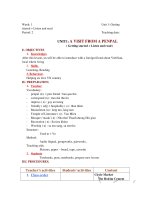English 9 Tiet 7 Unit 2 Getting Started Listen Read
Bạn đang xem bản rút gọn của tài liệu. Xem và tải ngay bản đầy đủ của tài liệu tại đây (124.21 KB, 3 trang )
<span class='text_page_counter'>(1)</span><div class='page_container' data-page=1>
<b>Week: 4 Date of preparing: 15/ 09/ 2012</b>
<b>Period: 7 Date of teaching: 17/ 09/ 2012</b>
UNIT 2: CLOTHING
<b>Lesson 1: GETTING STARTED - LISTEN AND READ</b>
<b>I. OBJECTIVES:</b>
1. Educational aims: Educate Ss to respect the Vietnamse traditional clothing.
2. Teaching aims : By the end of the lesson, Ss can talk about “Ao dai”, the traditional Vietnamse
clothing, get knowledge of other countries traditional clothings.
<b>II. PREPARATIONS: book, cassette tape, sub-board</b>
<b>III. PROCEDURES:</b>
<b>Teacher’s activities</b> <b>Students’activities</b>
<b>1. Warm - up (5’)</b>
<b>- Ask Ss to play a game</b>
“Guessing game”
1. It is the tranditional dress of
Vietnamese people
2. Vietnamese women wear it
to day.
<b>- Whole class</b>
+ Key: Ao dai
<b>2. Pre - reading (13’)</b>
<b>- </b>
Have Ss look at some tranditional clothes and
say the name of the coutries
<b>Clothes</b> <b>Countries</b>
1 Sari
2 Kimono
3 Kilt
4 Veil
5 Ao dai
6 Jeans
a Scotland
b Japan
c Arabia
d India
e Vietnam
f USA
<b>- Ask Ss some questions:</b>
1. Who often wear Ao dai?
<b>- Look at the pictures and say the names </b>
of the the countries
+ Key: 1-c
2-f
3-d
4-a
5-b
6-e
</div>
<span class='text_page_counter'>(2)</span><div class='page_container' data-page=2>
2. Do men wear Ao dai? When?
3. Is Ao dai now different from the one in the past?
<b>- Call some Ss to answer questions.</b>
<b>- Explain some new words:</b>
+ poet (n): / poem (n): / poetry (n):
+ stripe (n)
+ material (n)
+ occasion (n)
+ minority (n)
+ inspiration(n)
+ unique (a)
+ design (n) (v) / designer(n)
+ slit (n)
+ tunic (n)
+ fashion (n) / fashionable (adj)
<b>- Ask Ss to practice new words.</b>
<b>- Answer questions.</b>
<b>- Listen and write.</b>
<b>- Practice.</b>
<b>3. While - reading (20’)</b>
<b>- Play the tape for Ss 3 times, ask Ss to listen.</b>
<b>- Call some Ss read the text loudly before class.</b>
<b>- Have Ss read the text and complete the sentences.</b>
<b>- Call Ss to check.</b>
<b>- Have Ss read the text again and answer the </b>
questions (p.14)
1. Tranditionally,men and women used to wear Ao
dai.
2. Because it is convenient.
3. They’ve printed lines of poetry on it or have
added symbols.
<b>- Call some Ss to read the answer.</b>
<b>- Listen to the tape.</b>
<b>- Read the text loudly.</b>
<b>- Work in pairs.</b>
<b>- Read again and complete </b>
1. poems, novels, and songs
2. a long silk tunic with slits up the sides
worn over loose pants
3. to wear modern clothing at work
4. lines of poetry on it
5. symbols: sun, stars, crosses and
stripes.
<b>- Read the answer.</b>
<b>4. Post - reading (5’)</b>
<b>- Have Ss talk with their partner about Ao dai.</b>
<b>- Call some Ss share the ieads in front of class.</b> <b>- Pair works.- Give the iead in front of class.</b>
<b>5. Homework (2’)</b>
<b>- Ask Ss to reread the text, rewrite the answer.</b>
<b>- Prepare the next period: Unit 2: Speak/ p. 14</b> Take note.
<b>IV. COMMENTS:</b>
</div>
<span class='text_page_counter'>(3)</span><div class='page_container' data-page=3></div>
<!--links-->









